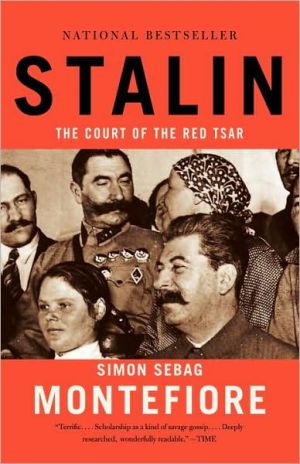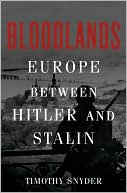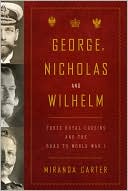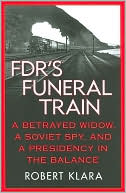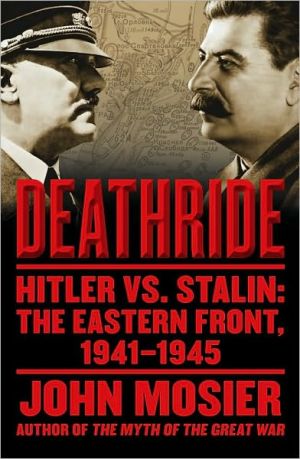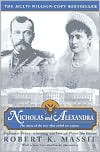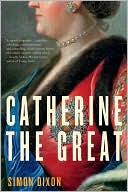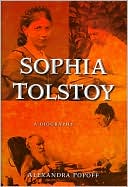Stalin: The Court of the Red Tsar
This widely acclaimed biography provides a vivid and riveting account of Stalin and his courtiers—killers, fanatics, women, and children—during the terrifying decades of his supreme power. In a seamless meshing of exhaustive research and narrative ?lan, Simon Sebag Montefiore gives us the everyday details of a monstrous life.We see Stalin playing his deadly game of power and paranoia at debauched dinners at Black Sea villas and in the apartments of the Kremlin. We witness first-hand how the...
Search in google:
This widely acclaimed biography provides a vivid and riveting account of Stalin and his courtiers—killers, fanatics, women, and children—during the terrifying decades of his supreme power. In a seamless meshing of exhaustive research and narrative ?lan, Simon Sebag Montefiore gives us the everyday details of a monstrous life.We see Stalin playing his deadly game of power and paranoia at debauched dinners at Black Sea villas and in the apartments of the Kremlin. We witness first-hand how the dictator and his magnates carried out the Great Terror and the war against the Nazis, and how their families lived in this secret world of fear, betrayal, murder, and sexual degeneracy. Montefiore gives an unprecedented understanding of Stalin’s dictatorship, and a Stalin as human and complicated as he is brutal. The New York Times In Stalin: The Court of the Red Tsar, Mr. Montefiore draws upon new archival material, unpublished memoirs and interviews with survivors of that era (including many children of Stalin's associates and underlings) to create a harrowing portrait of life in the dictator's inner circle. In doing so, he gives us an intimate look at Stalin himself and the culture of sadism, ruthlessness and dread that flourished around him, fueling a murderous regime that would leave tens of millions of people dead. — Michiko Kakutani
Chapter 1:\ The Georgian and the Schoolgirl\ Nadya and Stalin had been married for fourteen years but it extended deeper and longer than that, so steeped was their marriage in Bolshevism. They had shared the formative experiences of the underground life and intimacy with Lenin during the Revolution, then the Civil War. Stalin had known her family for nearly thirty years and he had first met her in 1904 when she was three. He was then twenty-five and he had been a Marxist for six years.\ Joseph Vissarionovich Djugashvili was not born on 21 December 1879, Stalin's official birthday. "Soso" was actually born in a tiny shack (that still exists) to Vissarion, or "Beso," and his wife Ekaterina, "Keke," née Geladze, over a year earlier on 6 December 1878. They lived in Gori, a small town beside the Kura River in the romantic, mountainous and defiantly un-Russian province of Georgia, a small country thousands of miles from the Tsar's capital: it was closer to Baghdad than St. Petersburg.* Westerners often do not realize how foreign Georgia was: an independent kingdom for millennia with its own ancient language, traditions, cuisine, literature, it was only consumed by Russia in gulps between 1801 and 1878. With its sunny climate, clannish blood feuds, songs and vineyards, it resembles Sicily more than Siberia.\ Soso's father was a violent, drunken semi-itinerant cobbler who savagely beat both Soso and Keke. She in turn, as the child later recalled, "thrashed him mercilessly." Soso once threw a dagger at his father. Stalin reminisced how Beso and Father Charkviani, the local priest, indulged in drinking bouts together to the fury of his mother: "Father, don't make my husband a drunk, it'll destroy my family." Keke threw out Beso. Stalin was proud of her "strong willpower." When Beso later forcibly took Soso to work as a cobbling apprentice in Tiflis, Keke's priests helped get him back.\ Stalin's mother took in washing for local merchants. She was pious and became close to the priests who protected her. But she was also earthy and spicy: she may have made the sort of compromises that are tempting for a penniless single mother, becoming the mistress of her employers. This inspired the legends that often embroider the paternity of famous men. It is possible that Stalin was the child of his godfather, an affluent innkeeper, officer and amateur wrestler named Koba Egnatashvili. Afterwards, Stalin protected Egnatashvili's two sons, who remained friends until his death and reminisced in old age about Egnatashvili's wrestling prowess. Nonetheless, one sometimes has to admit that great men are the children of their own fathers. Stalin was said to resemble Beso uncannily. Yet he himself once asserted that his father was a priest.\ Stalin was born with the second and third toes of his left foot joined. He suffered a pock-marked face from an attack of smallpox and later damaged his left arm, possibly in a carriage accident. He grew up into a sallow, stocky, surly youth with speckled honey-coloured eyes and thick black hair-a kinto, Georgian street urchin. He was exceptionally intelligent with an ambitious mother who wanted him to be a priest, perhaps like his real father. Stalin later boasted that he learned to read at five by listening to Father Charkviani teaching the alphabet. The five-year-old then helped Charkviani's thirteen-year-old daughter with her reading.\ In 1888, he entered the Gori Church School and then, triumphantly, in 1894, won a "five rouble scholarship" to the Tiflis Seminary in the Georgian capital. As Stalin later told a confidant, "My father found out that along with the scholarship, I also earned money (five roubles a month) as a choirboy . . . and once I went out and saw him standing there: " 'Young man, sir,' said Beso, 'you've forgotten your father . . . Give me at least three roubles, don't be as mean as your mother!'\ " 'Don't shout!' replied Soso. 'If you don't leave immediately, I'll call the watchman!' " Beso slunk away.* He apparently died of cirrhosis of the liver in 1909.\ Stalin sometimes sent money to help his mother but henceforth kept his distance from Keke whose dry wit and rough discipline resembled his own. There has been too much cod-psychology about Stalin's childhood but this much is certain: raised in a poor priest-ridden household, he was damaged by violence, insecurity and suspicion but inspired by the local traditions of religious dogmatism, blood-feuding and romantic brigandry. "Stalin did not like to speak about his parents and childhood" but it is meaningless to over-analyse his psychology. He was emotionally stunted and lacked empathy yet his antennae were supersensitive. He was abnormal but Stalin himself understood that politicians are rarely normal: History, he wrote later, is full of "abnormal people."\ The seminary provided his only formal education. This boarding school's catechismic teaching and "Jesuitical methods" of "surveillance, spying, invasion of the inner life, the violation of people's feelings" repelled, but impressed, Soso so acutely that he spent the rest of his life refining their style and methods. It stimulated this autodidact's passion for reading but he became an atheist in the first year. "I got some friends," he said, "and a bitter debate started between the believers and us!" He soon embraced Marxism.\ In 1899, he was expelled from the seminary, joined the Russian Social Democratic Workers' Party and became a professional revolutionary, adopting the nom de revolution Koba, inspired by the hero of a novel, The Parricide, by Alexander Kazbegi, a dashing, vindictive Caucasian outlaw. He combined the "science" of Marxism with his soaring imagination: he wrote romantic poetry, published in Georgian, before working as a weatherman at the Tiflis Meteorological Institute, the only job he held before becoming one of the rulers of Russia in 1917.\ "Koba" was convinced by the universal panacea of Marxism, "a philosophical system" that suited the obsessive totality of his character. The class struggle also matched his own melodramatic pugnacity. The paranoid secrecy of the intolerant and idiosyncratic Bolshevik culture dovetailed with Koba's own self-contained confidence and talent for intrigue. Koba plunged into the underworld of revolutionary politics that was a seething, stimulating mixture of conspiratorial intrigue, ideological nitpicking, scholarly education, factional games, love affairs with other revolutionaries, police infiltration and organizational chaos. These revolutionaries hailed from every background-Russians, Armenians, Georgians and Jews, workers, noblemen, intellectuals and daredevils-and organized strikes, printing presses, meetings and heists. United in the obsessional study of Marxist literature, there was always a division between the educated bourgeois émigrés, like Lenin himself, and the rough men of action in Russia itself. The underground life, always itinerant and dangerous, was the formative experience not only of Stalin but of all his comrades. This explains much that happens later.\ In 1902, Koba won the spurs of his first arrest and Siberian exile, the first of seven such exiles from which he escaped six times. These exiles were far from Stalin's brutal concentration camps: the Tsars were inept policemen. They were almost reading holidays in distant Siberian villages with one part-time gendarme on duty, during which revolutionaries got to know (and hate) each other, corresponded with their comrades in Petersburg or Vienna, discussed abstruse questions of dialectical materialism, and had affairs with local girls. When the call of freedom or revolution became urgent, they escaped, yomping across the taiga to the nearest train. In exile, Koba's teeth, a lifelong source of pain, began to deteriorate.\ Koba avidly supported Vladimir Lenin and his seminal work, What Is to Be Done? This domineering political genius combined the Machiavellian practicality of seizing power with mastery of Marxist ideology. Exploiting the schism that would lead to the creation of his own Bolshevik Party, Lenin's message was that a supreme Party of professional revolutionaries could seize power for the workers and then rule in their name in a "dictatorship of the proletariat" until this was no longer necessary because socialism had been achieved. Lenin's vision of the Party as "the advance detachment" of the "army of proletarians . . . a fighting group of leaders" set the militarist tone of Bolshevism.\ In 1904, on Koba's return to Tiflis, he met his future father-in-law Sergei Alliluyev, twelve years his senior, a skilled Russian electrical artisan married to Olga Fedorenko, a strong-willed Georgian-German-Gypsy beauty with a taste for love affairs with revolutionaries, Poles, Hungarians, even Turks. It was whispered that Olga had an affair with the young Stalin, who fathered his future wife, Nadya. This is false since Nadezhda was already three when her parents first met Koba, but his affair with Olga is entirely credible and he himself may have hinted at it. Olga, who, according to her granddaughter Svetlana, had a "weakness for southern men," saying "Russian men are boors," always had a "soft spot" for Stalin. Her marriage was difficult. Family legend has Nadya's elder brother Pavel seeing his mother making up to Koba. Such short liaisons were everyday occurrences among revolutionaries.\ Long before they fell in love, Stalin and Nadya were part of the Bolshevik family who passed through the Alliluyev household: Kalinin and Yenukidze among others at that dinner in 1932. There was another special link: soon afterwards, Koba met the Alliluyevs in Baku, and saved Nadya from drowning in the Caspian Sea, a romantic bond if ever there was one.\ Koba meanwhile married another sprig of a Bolshevik family. Ekaterina, "Kato," a placid, darkly pretty Georgian daughter of a cultured family, was the sister of Alexander Svanidze, also a Bolshevik graduate of the Tiflis seminary who joined Stalin's Kremlin entourage. Living in a hut near the Baku oilfields, Kato gave him a son, Yakov. But Koba's appearances at home were sporadic and unpredictable.\ During the 1905 Revolution, in which Leon Trotsky, a Jewish journalist, bestrode the Petersburg Soviet, Koba claimed he was organizing peasant revolts in the Kartli region of Georgia. After the Tsarist backlash, he travelled to a Bolshevik conference in Tammerfors, Finland-his first meeting with his hero, Lenin, "that mountain eagle." The next year, Koba travelled to the Congress in Stockholm. On his return, he lived the life of a Caucasian brigand, raising Party funds in bank robberies or "expropriations": he boasted in old age of these "heists . . . our friends grabbed 250,000 roubles in Yerevan Square!"\ After visiting London for a Congress, Koba's beloved, half-ignored Kato died "in his arms" in Tiflis of tuberculosis on 25 November 1907. Koba was heartbroken. When the little procession reached the cemetery, Koba pressed a friend's hand and said, "This creature softened my heart of stone. She died and with her died my last warm feelings for people." He pressed his heart: "It's desolate here inside." Yet he left their son Yakov to be brought up by Kato's family. After hiding in the Alliluyevs' Petersburg apartment, he was recaptured and returned to his place of banishment, Solvychegodsk. It was in this remote one-horse town in January 1910 that Koba moved into the house of a young widow named Maria Kuzakova by whom he fathered a son.* Soon afterwards, he was involved in a love affair with a schoolgirl of seventeen named Pelageya Onufrieva. When she went back to school, he wrote: "Let me kiss you now. I am not simply sending a kiss but am KISSSSSING you passionately (it's not worth kissing otherwise)." The locals in the north Russified "Iosef" to "Osip" and his letters to Pelageya were often signed by her revealing nickname for him: "Oddball Osip."\ After yet another escape, Koba returned to Petersburg in 1912, sharing digs with a ponderous Bolshevik who was to be the comrade most closely associated with him: Vyacheslav Scriabin, only twenty-two, had just followed the Bolshevik custom of assuming a macho nom de revolution and called himself that "industrial name" Molotov-"the hammer." Koba had also assumed an "industrial" alias: he first signed an article "Stalin" in 1913. It was no coincidence that "Stalin" sounds like "Lenin." He may have been using it earlier and not just for its metallic grit. Perhaps he borrowed the name from the "buxom pretty" Bolshevik named Ludmilla Stal with whom he had had an affair.\ This "wonderful Georgian," as Lenin called him, was co-opted by the Party's Central Committee at the end of the Prague conference of 1912. In November, Koba Stalin travelled from Vienna to Cracow to meet Lenin with whom he stayed: the leader supervised his keen disciple in the writing of an article expressing Bolshevik policy on the sensitive nationality question, henceforth Stalin's expertise. "Marxism and the National Question," arguing for holding together the Russian Empire, won him ideological kudos and Lenin's trust.\ "Did you write all of it?" asked Lenin (according to Stalin).\ "Yes . . . Did I make mistakes?"\ "No, on the contrary, splendid!" This was his last trip abroad until the Teheran Conference in 1943.\ In February 1913, Stalin was rearrested and given a suspiciously light exile: was he an agent of the Tsar's secret police, the Okhrana? The historical sensationalism of Stalin's duplicity shows a naïve misunderstanding of underground life: the revolutionaries were riddled with Okhrana spies but many were double or triple agents.* Koba was willing to betray colleagues who opposed him though, as the Okhrana admitted in their reports, he remained a fanatical Marxist-and that is what mattered.\ Stalin's final exile began in 1913 in the distant cold north-east of Siberia, where he was nicknamed "Pock-marked Joe" by the local peasants. Fearing more escapes, the exile was moved to Kureika, a desolate village in Turukhansk, north of the Arctic Circle where his fishing prowess convinced locals of magical powers and he took another mistress. Stalin wrote pitiful letters to Sergei and Olga Alliluyev: "Nature in this cursed region is shamefully poor" and he begged them to send him a postcard: "I'm crazy with longing for nature scenes if only on paper." Yet it was also, strangely, a happy time, perhaps the happiest of his life for he reminisced about his exploits there until his death, particularly about the shooting expedition when he skied into the taiga, bagged many partridges and then almost froze to death on the way back.\ The military blunders and food shortages of the Great War inexorably destroyed the monarchy which, to the surprise of the Bolsheviks, collapsed suddenly in February 1917, replaced by a Provisional Government. On 12 March, Stalin reached the capital and visited the Alliluyevs: once again, Nadya, a striking brunette, sixteen, her sister Anna and brother Fyodor, questioned this returning hero about his adventures. When they accompanied him by tram towards the offices of the newspaper Pravda, he called out, "Be sure to set aside a room in the new apartment for me. Don't forget." He found Molotov editing Pravda, a job he immediately commandeered for himself. While Molotov had taken a radical anti-government line, Stalin and Lev Kamenev, né Rosenfeld, one of Lenin's closest comrades, were more conciliatory. Lenin, who arrived on 4 April, overruled Stalin's vacillations.\ In a rare apology to Molotov, Stalin conceded, "You were closer to Lenin . . ." When Lenin needed to escape to Finland to avoid arrest, Stalin hid him chez Alliluyev, shaved off his beard and escorted him to safety.
\ From Barnes & NobleOf all modern human monsters, Josef Stalin (1879-1953) is perhaps the most fascinating. The vengeful dictator who dispatched untold millions held an abiding love for Pushkin, film, and classical music. Using primary research, Simon Segar Montefiore has constructed a life of the Soviet tyrant that mixes stories of his volatile public life with previously unknown details about his domestic idiosyncrasies. Who knew, for instance, that Stalin took breaks from signing extermination orders to play billiards; or that the author of the Great Terror always retained a sentimental attachment to the Orthodox hymns of his youth? This masterful biography doesn't humanize Stalin; it simply makes his brutal acts seem more visceral.\ \ \ \ \ The New York TimesIn Stalin: The Court of the Red Tsar, Mr. Montefiore draws upon new archival material, unpublished memoirs and interviews with survivors of that era (including many children of Stalin's associates and underlings) to create a harrowing portrait of life in the dictator's inner circle. In doing so, he gives us an intimate look at Stalin himself and the culture of sadism, ruthlessness and dread that flourished around him, fueling a murderous regime that would leave tens of millions of people dead. — Michiko Kakutani\ \ \ The Washington PostThe result is a portrait of Stalin and the members of his court that is unprecedented in its intimacy and horrifying in its implications, not merely because it shows that the engineers of one of history's greatest holocausts were depraved -- there has always been ample evidence of that -- but also because they emerge in these pages as surprisingly normal. This raises the possibility that, under the influence of the appropriate ideas and with the right career incentives, crimes like those of the Stalinist regime could be committed by people like ourselves. — David Satte\ \ \ \ \ The New YorkerAny biography of a tyrant runs the risk of humanizing its subject to the point of appearing to mitigate his crimes. But Montefiore’s intimate portrait actually throws the coldhearted murderousness with which Stalin pursued and defended power into sharper relief. The book—much of it based on fresh archival material—moves smoothly between detailed sketches of everyday life at the Kremlin and accounts of the paranoid and sanguinary scheming that determined Soviet politics. This juxtaposition captures the vertiginous quality of life in Stalin’s court, where no allegiance was permanent. Just as strikingly, Montefiore shows how Stalin, a “master of friendships,” used charm to win the support of members of the Party’s inner circle (many of whom ended up regretting it). This haunting book gets us as close as we are likely to come to the man who believed that “the solution to every human problem was death.”\ \ \ \ \ Publishers WeeklyMontefiore (The Prince of Princes: The Life of Potemkin) is more interested in life at the top than at the bottom, so he includes hundreds of pages on Stalin's purges of top Communists, while devoting much less space to the forced collectivization of Soviet peasants that led to millions of deaths. In lively prose, he intersperses his mammoth account of Stalin's often-deadly political decisions with the personal lives of the Soviet dictator and those around him. As a result, the reader learns about sexual peccadilloes of the top Communists: Stalin's secret police chief Lavrenti Beria, for one, "craved athletic women, haunting the locker rooms of Soviet swimmers and basketball players." Stalin's own escapades after the death of his wife are also noted. There's also much detail about the food at parties and other meetings of Stalin's henchmen. The effect is paradoxical: Stalin and his cronies are humanized at the same time as their cruel misdeeds are recounted. Montefiore offers little help in answering some of the unsettled questions surrounding Stalin: how involved was he in the 1934 murder of rising official Sergei Kirov, for example. He also seems to leave open the question of Stalin's paranoia: he argues that the Georgian-born ruler was a charming man who used his people skills to get whatever he wanted. Montefiore mainly skirts the paranoia issue, noting that only after WWII, when Stalin launched his anti-Semitic campaigns, did he "become a vicious and obsessional anti-Semite." There are many Stalin biographies out there, but this fascinating work distinguishes itself by its extensive use of fresh archival material and its focus on Stalin's ever-changing coterie. Maps and 24 pages of photos not seen by PW. Agent, Georgina Capel. (Apr.) Forecast: With a 75,000 first printing, this is likely to draw in Slavophiles and history buffs. Copyright 2004 Reed Business Information.\ \ \ \ \ Library JournalThe mission of this large work by Montefiore (Prince of Princes: The Life of Potemkin) is to "go beyond the traditional explanations of Stalin as `enigma,' `madman,' or `Satanic genius' and that of his comrades as `men without biographies,' dreary moustachioed sycophants in black-and-white photographs." In other words, he seeks to reorient our historical perspective by giving us a more intimate account of these men. To do so, he places Stalin and his "oligarchs" in idiosyncratic Bolshevik context as members of a military-religious "order of sword-bearers," getting up close and personal as he describes relationships among the most notable of Stalin's courtiers, including Molotov, Beria, Yezhov, Zhadanov, Kaganovich, and Khrushchev. Montefiore echoes such contemporary works as Roy Medvedev's The Unknown Stalin: His Life, Death, and Legacy and Jonathan Brent's Stalin's Last Crime: The Plot Against the Jewish Doctors, 1948-1953, but he also goes beyond them. For instance, he describes the last days of Stalin in greater detail than have other authors. While Montefiore does not humanize his subjects, he does make them more understandable, if no less repellant. Recommended for academic libraries and public libraries with a strong Soviet/Russian collection. Harry Willems, Southeast Kansas Lib. Syst., Iola Copyright 2004 Reed Business Information.\ \ \ \ \ Kirkus ReviewsA fascinating, superbly written study of the Red Emperor Josef Stalin, "an energetic and vainglorious melodramatist who was exceptional in every way."Stalin, the one-time seminarian from Georgia, was at once a ruthlessly efficient administrator and a born outlaw (during the Civil War he funded his guerrilla activities by robbing banks), capable of commanding both fear and respect, though always preferring the former. He was careful throughout his long rule to surround himself with equally capable if easily intimidated lieutenants, whom the young British historian/novelist Montefiore (Enigma, 2001, etc.) characterizes wonderfully: Stalin's favorite secret policeman, Genrikh Yagoda, "a ferret-faced Jewish jeweler's son from Nizhny Novgorod with a ‘Hitlerish moustache' and a taste for orchids, German pornography, and literary friendships"; Vyacheslav Molotov, the Marxist true believer, "small, stocky, with a bulging forehead, chilling hazel eyes blinking behind round spectacles, and a stammer when angry (or talking to Stalin)." They created an extraordinary terror state indeed, so terrible that Stalin's iron-hard Bolshevik wife committed suicide after it became clear that he had thoroughly betrayed the revolution (and behaved monstrously toward her to boot). Yet there were some curious blind spots in Stalin's total state, as well as in his understanding of the world: for all the evidence to the contrary, for instance, he could not believe that Hitler was planning an invasion of the Soviet Union, growling, "Germany will never fight Russia on her own" (and Germany didn't: Hitler brought allies to the fight) and insisting that the German attacks of June 1941 were the work of renegade generals,not of Hitler himself. "The duel between those two brutal and reckless egomaniacs," as Montefiore puts it, bled Russia dry and nearly brought Stalin's government down; but the terror state would fall only with Stalin's death in 1953, whereupon his surviving aides, "relieved to be alive," were dumped into the ashbin of history. There is much news here (including the fate of Hitler's bones), and much to ponder. Altogether extraordinary, and required reading for anyone interested in world affairs. First printing of 75,000\ \
